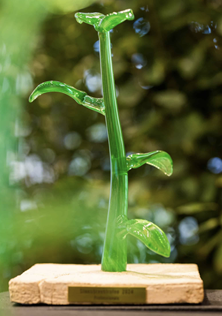Ten years of lifting paving stones
On 9 October, Stichting Steenbreek celebrated its 10th anniversary in the Forum. Over the past 10 years, this foundation has witnessed growing enthusiasm among citizens for removing paving stones from their gardens and replacing them with plants. Some 120 municipalities are now affiliated with Steenbreek. And it all started a little over 10 years ago at the UG.
Text: Marit Nygard, UG Science Shops
Piet Kuiper, emeritus Professor of Plant Ecology, had noticed a worrying trend. His home environment in Haren was becoming increasingly grey as more and more of his neighbours decided to pave over their front and back gardens. Low maintenance, but an eyesore to a plant ecologist. Not only because of how it looked, but also because of the harm it was causing to urban ecology. In 2013, when the field of urban ecology was still finding its way, Kuiper was a pioneer. He mobilized some of his colleagues in Wageningen and elsewhere, and asked for help from the UG Beta Science Shop. Together, they formed the "Committee for discouraging the paving of private gardens''.
They faced a stiff scientific challenge, as simply looking around and seeing paving stones was not enough to back up their arguments against laying paving stones. They needed methods and models that they could use to objectively measure the number of paving stones and explore the consequences for urban ecology. Cirsten Zwaagstra, Master’s student of Environmental Science at the UG, accepted the challenge and started researching the paving in a number of neighbourhoods in Groningen, including examining the effects it was having on water regulation and heat stress.
There was plenty to do in terms of ecological research. As there were no maps of the city showing what people were doing in their back gardens and drones had not yet come onto the scene, the only solution was to knock on people’s doors, one neighbourhood at a time. The pilot project was conducted in the ‘Professoren’ neighbourhood, where the researchers found extensive paving.

So why is this such a problem? Paving stones ensure that rainwater goes straight into the gutters and sewers. Water is retained for longer in gardens with plants, preventing the sewers from overflowing during extreme rainfall. Paving stones retain much more heat, which means that Groningen is significantly warmer than the Ommeland on hot summer days and nights. The effects include problems with the infrastructure (such as bridges and drinking water quality), as well as more serious health problems such as increased mortality. These problems are being exacerbated in urban areas by ongoing climate change.
It soon became obvious that the problem needed more attention, and the “Committee for discouraging the paving of private gardens” thrived. However, the lengthy name of the committee needed to go, and so it was replaced by Stichting Steenbreek, (which roughly translates as The Paving Stone Lifting Foundation).
What is Steenbreek?
Stichting Steenbreek has not stood still in its first 10 years. Activities vary from paving stone lifting competitions and communal paving stone collections, to actively influencing municipal policy. Their work covers a wide field, based on four themes (biodiversity, climate adaptation, social cohesion, and health).
Wout Veldstra, the then-Groningen urban ecologist, was the key figure. Urban ecology was new; Veldstra was only the fifth urban ecologist in the Netherlands. The larger nature organizations in particular were not enamoured with urban ecology. Cities, which they saw as “already beyond being helped”, drew attention away from the problems in natural areas and parks. Luckily, things were not quite as black-and-white as this. Cities are by no means free from nature; in fact it even emerges between the paving stones when you are not looking.
When the Paris Agreement was signed in 2015, Steenbreek suddenly gained momentum. The new focus on heat and biodiversity threw the Steenbreek mission into the spotlights, and partnerships came from every direction. The foundation’s main focus is on carrying out research, always with the help of students. Student research from the Science Shops can, for example, evolve into a national phenomenon and shape environmental policy.
Steenbreek has just completed a reorganization and is now setting its sights on the future. Chair Wout Veldstra, now 74, plans to stay in this post for a little while longer, but is also keen to pass on the baton.

Even after 10 years, the enthusiasm in the group is still palpable. There was a lively atmosphere on the Groendag [Green Day] that took place in the Forum. All those present felt a connection with greening in some way, from civil servants to paving stone lifters. It was also the occasion for awarding the prize for the Paving stone lifter of the year to the organization and citizens who carried out the most influential green activity. This is not only judged on the amount of plants that have been added, but also on the approach and social impact of the activity.
The growing interest in urban ecology has clearly shown that biodiversity in towns and cities is often more extensive and offers greater potential than the ''green asphalt" provided by fields and meadows surrounding urban areas. Moreover, nature in cities encourages citizens to do their bit, by joining forces to remove paving stones from their gardens and pavements, and plant more greenery in their neighbourhood. And it’s all down to Steenbreek. Piet Kuiper (sadly deceased) would have been very proud.
More information
More news
-
19 December 2025
Mariano Méndez receives Argentine RAÍCES award
-
18 December 2025
Why innovate, and for whom?
-
17 December 2025
Ben Feringa wins Feynman Prize
